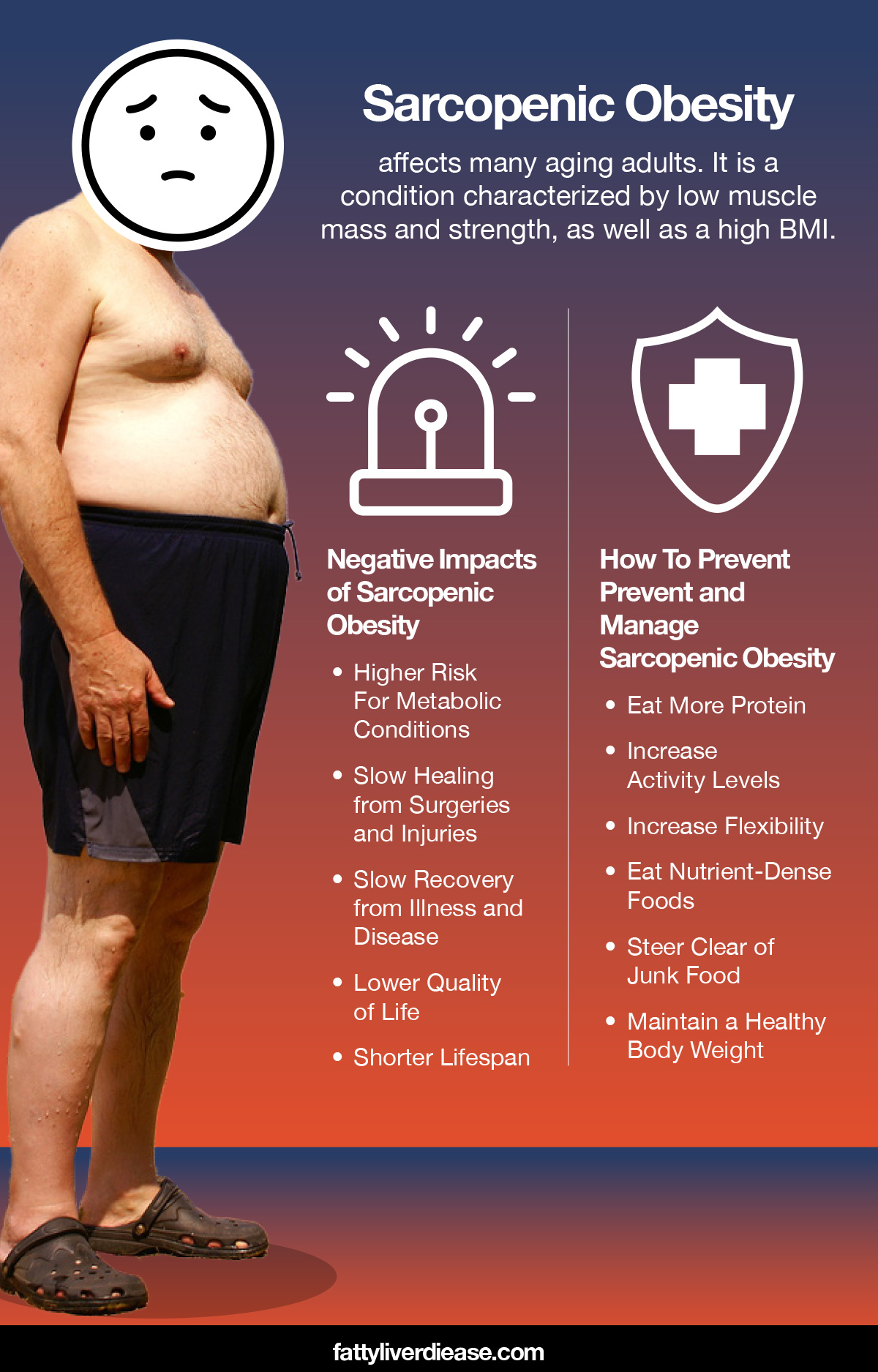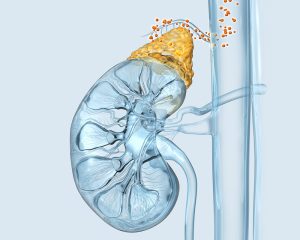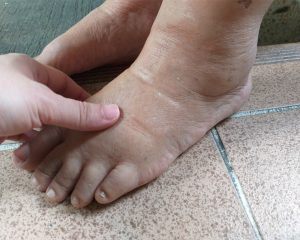Sarcopenic obesity is a common issue that affects many aging adults. You may think that the term “sarcopenic obesity” just refers to weight gain that occurs with age. However, sarcopenic obesity is a condition that affects the geriatric population and can impact health outcomes and quality of life. Figuring out sarcopenic obesity and how to reverse and prevent it may be one of the keys to maintaining longevity and quality of life through old age.
Read on to find out what you need to know about sarcopenic obesity and what you can do about it.
What Is Sarcopenic Obesity?
Sarcopenic obesity or sarcopenia obesity can be thought of as a combination of two conditions: sarcopenia and obesity. To better understand sarcopenic obesity, let’s first look at sarcopenia and obesity separately.
Sarcopenia
Sarcopenia is a term that describes the natural decrease in muscle mass as we get older. Did you know that starting around 30 years old, we begin to lose approximately 1% of our lean muscle mass each year? By later adulthood, muscle wasting may be so severe that quality of life and mobility are impacted. As a result, the prevalence of sarcopenia is higher across older individuals.
Sarcopenia can be difficult to quantify and has been measured by researchers in different ways. For example, some researchers may look at muscle mass while others look at muscle strength and muscle quality. Historically, muscle mass has been examined as an anthropometric determinant of sarcopenia. However, it seems that muscle strength is also a determinant of sarcopenia. A systematic review and meta-analysis published in Geriatrics & Gerontology International included longitudinal studies found on PubMed, Cochrane, and Embase that assessed grip strength among adults over 60 years old. Results found that better baseline grip strength helped prevent deterioration in cognition, mobility, mortality, and mobility at follow-up. (1)
Obesity
Obesity is a condition that describes excess fat accumulation. Obesity is a public health issue. It has a high prevalence rate in the United States and affects millions of Americans. In fact, the 2017-2018 National Health and Nutrition Examination Survey found that the prevalence rate of obesity among American adults was 42.4%. (2) Medically, obesity is defined as having a body mass index (BMI) above 30. Though there may be a genetic component to obesity, it is largely a result of a sedentary lifestyle in combination with excess calorie consumption and a high intake of sugar, refined grains, and saturated fat. Obesity is often a predictor of metabolic syndrome and risk of other conditions.
Obesity and aging go hand-in-hand. As we get older, cellular changes fueled by aging mean that the metabolism slows down, hormone levels change, and we become more prone to weight gain and higher body fat levels.
The Link Between Sarcopenia and Obesity
The pathogenesis of sarcopenia and obesity are related, leading to sarcopenic obesity. Sarcopenia can contribute significantly to obesity because of the critical role muscle tissue plays in health and wellbeing. Muscle tissue is important for supporting the function of the immune system, metabolism, and numerous other organ systems. Epidemiology shows that sarcopenia is most common among older adults.
Without adequate muscle mass, the metabolism becomes sluggish, leading to weight gain and higher adiposity. Cells are unable to rapidly process sugar and glucose, which can worsen high blood sugar and insulin resistance. Moreover, muscle wasting can result in frailty and inactivity, which worsens a sluggish metabolism.
When the metabolism is inefficient, weight gain occurs much more readily. When the body doesn’t know what to do with the energy it intakes, much of it is converted to fat and distributed throughout the body as adipose tissue. In turn, sarcopenia directly contributes to obesity.
Obesity may worsen sarcopenia because inflammation, excess weight, and associated conditions can slow down the metabolism, discourage physical activity, and impede muscle synthesis. Like the prevalence of either obesity or sarcopenia, the prevalence of sarcopenic obesity is higher among older adults.
The Impact of Sarcopenic Obesity in Older Adults
Older men and women are particularly vulnerable to sarcopenic obesity. Though we’ve touched on a few of the negative impacts of sarcopenic obesity on the body, let’s break them down into individual sections. A review published in Frontiers of Endocrinology and compiled by Korean researchers provides a detailed compilation of studies that describe exactly how sarcopenic obesity impacts health outcomes. (3) Moreover, a review published in Geriatrics explores some of the phenotypes and key clinical presentations of sarcopenic obesity. (4)
Metabolic Conditions
Sarcopenic obesity is one of the risk factors for developing metabolic syndrome. Obesity in elderly people can also be harmful to overall metabolism. Unlike muscle tissue, fat tissue is unhealthy and increases systemic inflammation. In particular, visceral fat around the organs in the abdomen can negatively impact cardiovascular health. This kind of obesity is called abdominal obesity or central obesity. Visceral adipocytes surrounding organs release cytokines and other inflammatory agents that contribute to disease risk. Research shows that obesity and sarcopenic obesity are linked to an increased risk of type 2 diabetes. (4)
Sarcopenic obesity and a larger waist circumference are linked to a variety of non-communicable conditions like type 2 diabetes, insulin resistance, and fatty liver disease.
Slow Healing from Surgeries and Injuries
Muscle tissue is important for helping the body recover following surgery or injury. Muscle tissue fortifies the immune system and helps provide some of the raw materials that the body needs to rebuild skin, muscle, and connective tissues. Sarcopenic patients may be at a higher risk of experiencing surgical complications. (4)
Slow Recovery from Illness and Disease
Individuals with sarcopenic obesity may also experience a slower recovery from illness and disease. One key example is liver cirrhosis. Individuals with liver cirrhosis tend to be at a higher risk of muscle wasting. However, this muscle wasting worsens the outcomes for individuals with liver cirrhosis. Maintaining muscle mass, muscle strength, and a healthy weight with liver disease can improve health outcomes and help you fight disease more effectively.
Lower Quality of Life
Older people are prone to muscle wasting and weight gain, which impairs physical function and physical performance. Muscle tissue supports bones and joints by fortifying them and diverting pressure. Elderly adults with more muscle tissue tend to experience fewer falls and fewer hospitalizations. They also tend to be more active and enjoy a higher quality of life on a daily basis.
Older men and older women without muscle mass are more likely to experience debilitating joint pain, lower levels of mobility, higher rates of physical disability, and less independence. They are also more likely to experience falls that lead to serious injury, hospitalization, and physical impairment in daily life.
Shorter Lifespan
Ultimately, sarcopenic obesity can impact longevity and may cause you to live a shorter life than you otherwise would without sarcopenic obesity. Preventing and reversing sarcopenic obesity can elongate your lifespan and allow you to get the most out of your later years.
What Can You Do to Prevent and Manage Sarcopenic Obesity
The good news is that there are steps you can take to help prevent and manage sarcopenic obesity. Research reveals that diet and exercise adjustments are the most effective strategies for improving body composition and treating sarcopenic obesity. (5)
1. Eat More Protein
The value of protein in the diet for sarcopenic obesity cannot be overstated. Protein is made up of tiny organic compounds called amino acids. The two major classes of amino acids are nonessential and essential amino acids. The body can only synthesize nonessential amino acids internally, and therefore requires the nutritional intake of essential amino acids on a daily basis. There are nine essential amino acids, including leucine, isoleucine, valine, histidine, lysine, phenylalanine, tryptophan, tyrosine, and methionine. When the body obtains optimal ratios of essential amino acids on a daily basis, it is able to efficiently boost muscle synthesis, metabolic processes, and immune system function.
Many older adults are not consuming adequate amounts of protein to encourage muscle synthesis. Here are a couple of tips for how to up your protein intake for sarcopenic obesity:
- Incorporate protein into every meal and snack. It’s a good idea to incorporate protein into every meal or snack that you eat. This habit can dramatically increase your protein intake over the course of the day. For example, eat eggs for breakfast; enjoy nuts and seeds for snack; eat nonfat Greek yogurt for lunch; and eat grilled chicken as part of a balanced dinner.
- Make smoothies. Smoothies and shakes are a great way to boost your protein intake. Plus, they can be really tasty and almost serve as a decadent dessert!
- Plan your meals. Planning your meals and snacks ensures that you won’t be caught without high-protein food. Making a weekly schedule of breakfast, lunch, dinner, and snack options can keep you on track with your protein intake.
Supplements
For older adults especially, upping daily protein intake won’t be sufficient to meet the body’s amino acid demands. Changes in the digestive system in older adulthood can cause the body to utilize dietary protein less efficiently. In younger adults, the digestive system efficiently breaks down protein particles into individual amino acids. The membrane in the intestines then absorbs these amino acids and sends them throughout the body to be used in various biological processes.
However, the digestive systems of older adults are not as efficient and effective as they once were. As a result, when an older adult and a younger adult consume the same number of grams of protein, chances are the body of the older adult is unable to reap all of the benefits of the amino acids in that protein.
This is where supplementation comes into play. Supplements can offer optimal ratios of essential amino acids in their individual form. This helps ensure that you are getting the essential amino acids your body needs to build muscle tissue and fight sarcopenia. Make sure that you research supplement brands and choose a high-quality supplement to support your health.
2. Increase Activity Levels
Staying active is key to building lean body mass and fighting sarcopenic obesity. First of all, exercising regularly keeps your muscles moving. When we use our bodies, muscle fibers are stimulated to build stronger muscle tissue.
Moreover, staying active burns calories. When striving to lose weight and fight against obesity, achieving a calorie deficit is key. Being in a calorie deficit means that you are burning more energy than you consume. When in a calorie deficit, the body reaches for energy reserves stored in the body, resulting in weight loss.
Increasing your activity levels doesn’t mean engaging in hardcore workouts every day. Instead, finding convenient ways to being more active is a good way to increase your activity in everyday life. For example, maybe you choose to take the stairs instead of the elevator, or you take the dog for a longer walk than you normally do. Or, you meet a friend for a walk instead of for lunch. Small changes can make a big difference in sarcopenic obesity.
3. Increase Flexibility
Flexibility can help support muscle synthesis in older adults. Engaging in regular stretching can help improve muscle function and encourage healthy muscle development. Increased flexibility can also help older adults avoid injury and lead a more active life. Yoga is an effective flexibility-enhancing activity.
4. Eat Nutrient-Dense Foods
Here are some examples of nutrient-dense foods to incorporate into your diet.
- Fruits and vegetables: Eating more fresh fruits and vegetables is an excellent way to increase your intake of vitamins, minerals, and antioxidants. Plus, fruits and vegetables contain relatively few calories, meaning you can eat a larger volume for fewer calories. Plus, fruits and veggies help lower systemic inflammation and neutralize free radicals that cause oxidative stress. The result is a more streamlined metabolism and more efficient muscle-building mechanisms.
- Whole grains: Whole grains are packed with nutritious components like fiber, vitamins, minerals, and protein. Foods like brown rice, quinoa, and whole-grain bread provide energy without spiking blood sugar.
- Nuts and seeds: Nuts and seeds are packed with fiber, protein, vitamins, and minerals, as well as healthy polyunsaturated and monounsaturated fats. Reach for nuts and seeds like pecans, walnuts, cashews, almonds, chia seeds, flaxseeds, and pumpkin seeds.
- Lean meat and dairy: Lean meat and dairy offer optimal ratios of essential amino acids. Reach for foods like chicken, turkey, nonfat Greek yogurt, and low-fat cheese.
- Fatty fish: Fatty fish offers omega-3 fatty acids, which work as potent anti-inflammatory agents. Eicosapentaenoic acid (EPA) and docosahexaenoic acid (DHA) are the omega-3 fatty acids found in fish like salmon, Arctic char, mackerel, and sardines. EPA and DHA reduce inflammation and help metabolic and muscle synthesis processes work more efficiently.
5. Steer Clear of Junk Food
Junk foods wreak havoc on your metabolism, immune system, and overall health. During younger years, the body is able to more effectively process junk foods. However, poor eating habits catch up to us in older age, when cells and organ systems function more slowly. Changing your eating habits and cutting out junk foods is a huge step in preventing and managing sarcopenic obesity.
Shifting your diet to include more healthy foods and fewer junk foods is an extremely effective strategy for fighting sarcopenic obesity. Steer clear of foods such as:
- Added sugars: Added sugars have been removed from their original source and artificially added into products like candy, baked goods, ice cream, condiments, and other packaged food items. Consuming high amounts of added sugar over time contributes to insulin resistance, weight gain, type 2 diabetes, and fatty liver disease.
- Refined grains: Refined grains and added sugars have the same impact on the body. Like added sugars, refined grains cause blood sugar levels to spike and over time contribute to metabolic conditions.
- Fatty meat and dairy: Though fatty meat and dairy products may contain protein, they are also filled with unhealthy saturated fat. Eating high amounts of saturated fat over time contributes to insulin resistance, weight gain, type 2 diabetes, fatty liver disease, and cardiovascular disease. Stay away from foods like fatty cuts of steak, pork, cured meats, full-fat yogurt, whole milk, and cheese.
- Fried foods: Fried foods are packed with saturated fats and trans fats that impeded muscle synthesis and cause weight gain; a dangerous recipe for sarcopenic obesity. Stay away from all fried foods like French fries, hush puppies, and onion rings.
- Packaged foods: Packaged foods often contain many of the above unhealthy ingredients, as well as preservatives and sodium.
6. Maintain a Healthy Body Weight
Weight loss is an important strategy for managing sarcopenic obesity. However, it’s critical to lose weight in a healthy way. Avoid all crash diets that severely restrict caloric intake. These diets often backfire and lead to binge eating and weight regain. Instead, consume the right number of calories for your age and activity level. On average, an adult should consume around 2000 calories per day. Moreover, regular exercise helps you burn calories, build muscle mass, and lose weight without losing lean muscle.
What to Eat If You Have Sarcopenic Obesity
Do you have sarcopenic obesity, but you’re not sure where to start in terms of changing your eating habits? Here are a few protein-rich meal ideas to incorporate into your diet.
Egg White Omelet
An egg white omelet is an optimal food for providing high-quality protein without too many calories. To prepare an egg white omelet, simply pour egg whites into a pan. Top with diced peppers, onions, sun-dried tomatoes, mushrooms, and a sprinkle of low-fat mozzarella cheese. Season your omelet with salt, pepper, and hot sauce if desired. When the egg white is cooked, fold over your omelet and enjoy with a slice of whole-grain toast.
Protein-Packed Wrap
A wrap is an easy meal to prepare and bring with you on the go. To prepare a low-carb and protein-rich lunch, choose a grain-free wrap made with almond flour or cassava flour. Top with black beans, peppers, onions, chopped spinach, tomatoes, grilled chicken, low-fat cheese, guacamole, cilantro, and a squeeze of lime.
Tofu and Veggie Stir Fry
A meal of tofu and veggies provides protein, vitamins, and antioxidants. Saute tofu in a pan with your choice of vegetables, such as onions, snap peas, carrots, bell peppers, broccoli, and cauliflower. Season with coconut milk, curry powder, salt, pepper, ginger, and lemon. Serve over brown rice or quinoa.
Protein Drink
If you need a boost of protein without the calories, try making a protein drink. Simply mix a high-quality essential amino acid powder into water, and enjoy! You can ensure that you’re getting optimal ratios of essential amino acids, without additives like sugar.
Trail Mix
Trail mix is a hearty snack that can help you feel satiated between meals. Nuts are rich in protein, fiber, minerals, and antioxidants. Try tossing together walnuts, pecans, almonds, and a few dark chocolate pieces.
Things to Keep in Mind
Sarcopenic obesity can also be related to underlying conditions. For example, an individual may be at a higher risk of sarcopenic obesity as a complication of cancer and immune system disorders. (3) Sarcopenia as a result of these underlying conditions is specifically referred to as cachexia. (3) If you have underlying conditions or comorbidities affecting your health, it’s best to get medical advice from your doctor or healthcare provider about how to best combat associated sarcopenic obesity.
Keep in mind that there is a phenomenon backed by research called the obesity paradox. The obesity paradox describes that in certain instances, older individuals who are obese may be at a lower risk of mortality. This association seems to be related to muscle mass. Obese subjects tend to have not only high fat mass but also higher muscle mass percentages. The extra muscle mass helps increase strength and exerts a protective effect. Individuals who lose large amounts of weight are at a higher risk of loss of muscle mass, and therefore tend to be at a higher risk for weakness and injury. As a result, it’s important to pursue weight loss in a healthy way and to focus on building lean skeletal muscle mass, regardless of your overall weight.
What to Do About Sarcopenic Obesity: Conclusion
Sarcopenic obesity is a condition that affects the elderly population and is characterized by low muscle mass and strength, as well as a high BMI. Individuals with sarcopenia may be at a higher risk of weakness, injury, metabolic syndrome, and mortality. Sarcopenic obesity can be prevented and managed with a combination of diet and lifestyle changes, such as a high-protein diet and regular physical activity.

References:
(1) https://pubmed.ncbi.nlm.nih.gov/26016893/
(2) https://www.cdc.gov/nchs/products/databriefs/db360.htm
(3) https://www.frontiersin.org/articles/10.3389/fendo.2020.00332/full























